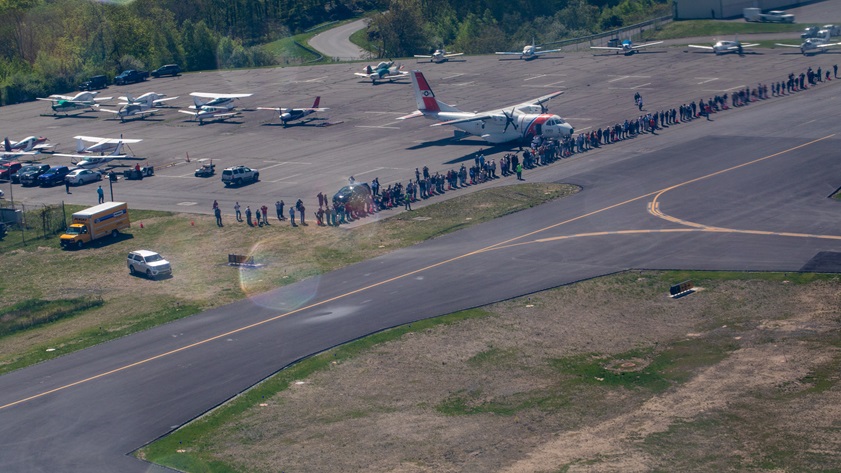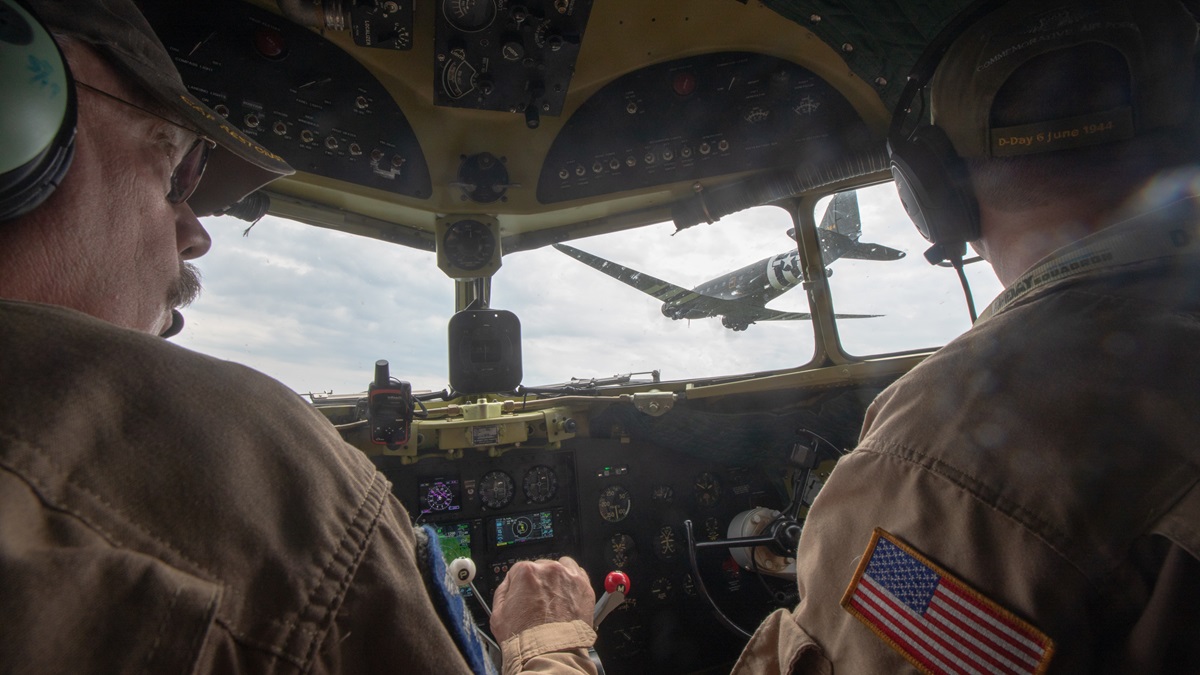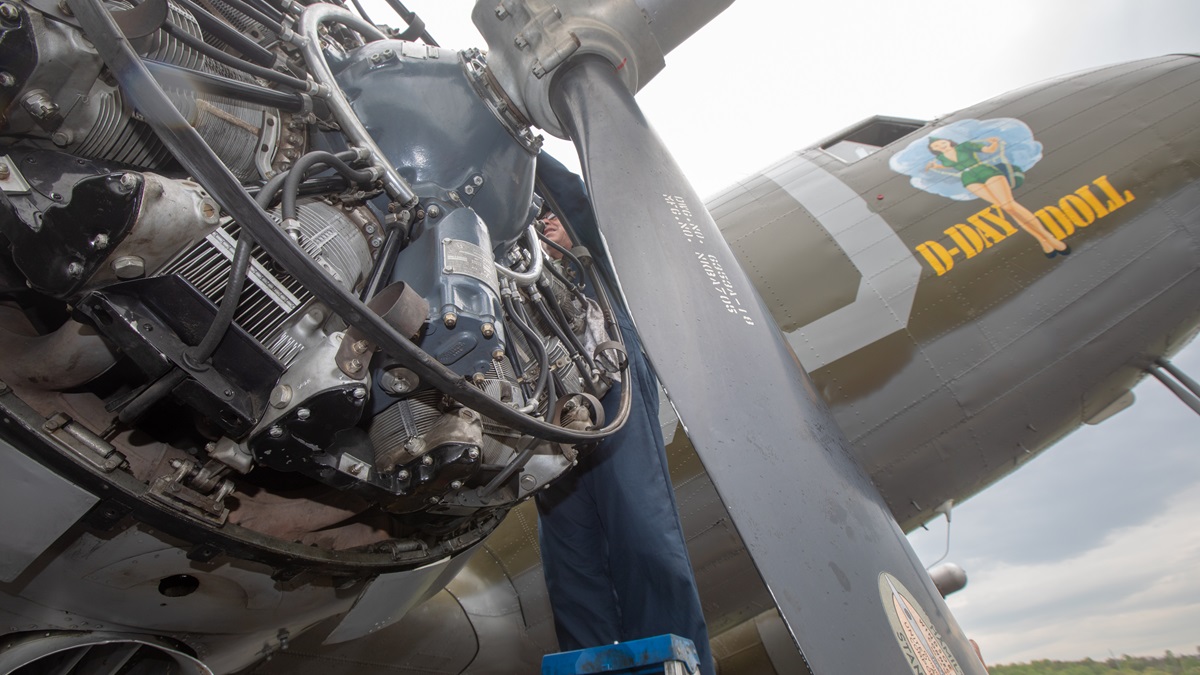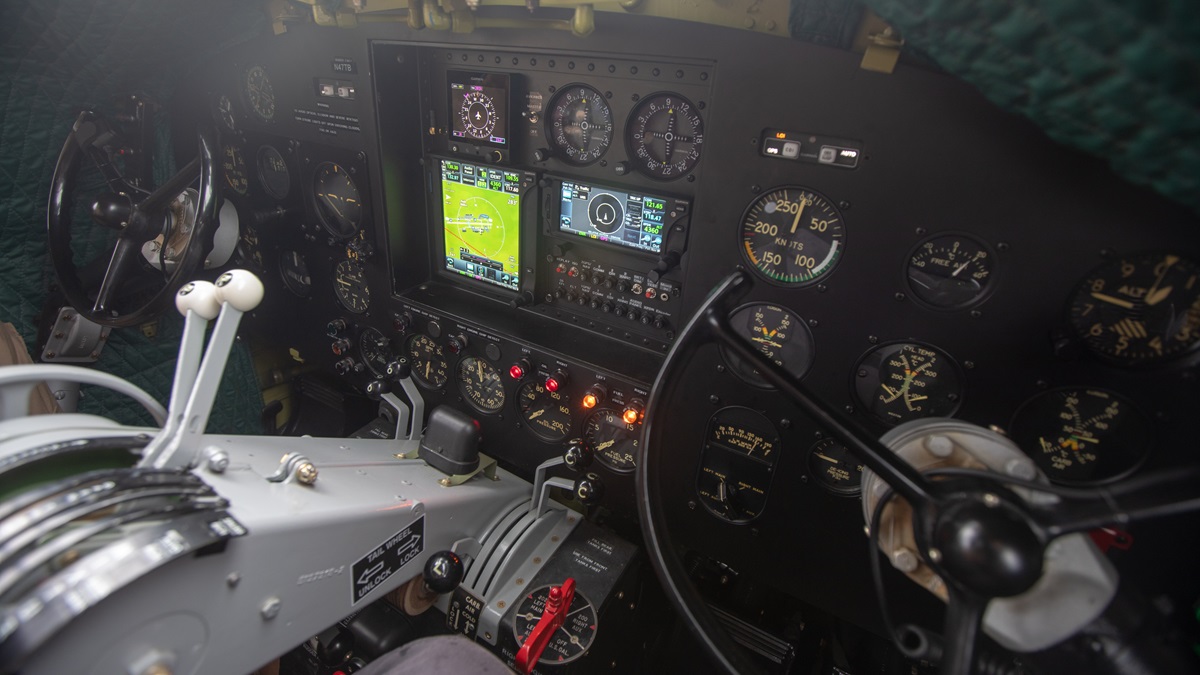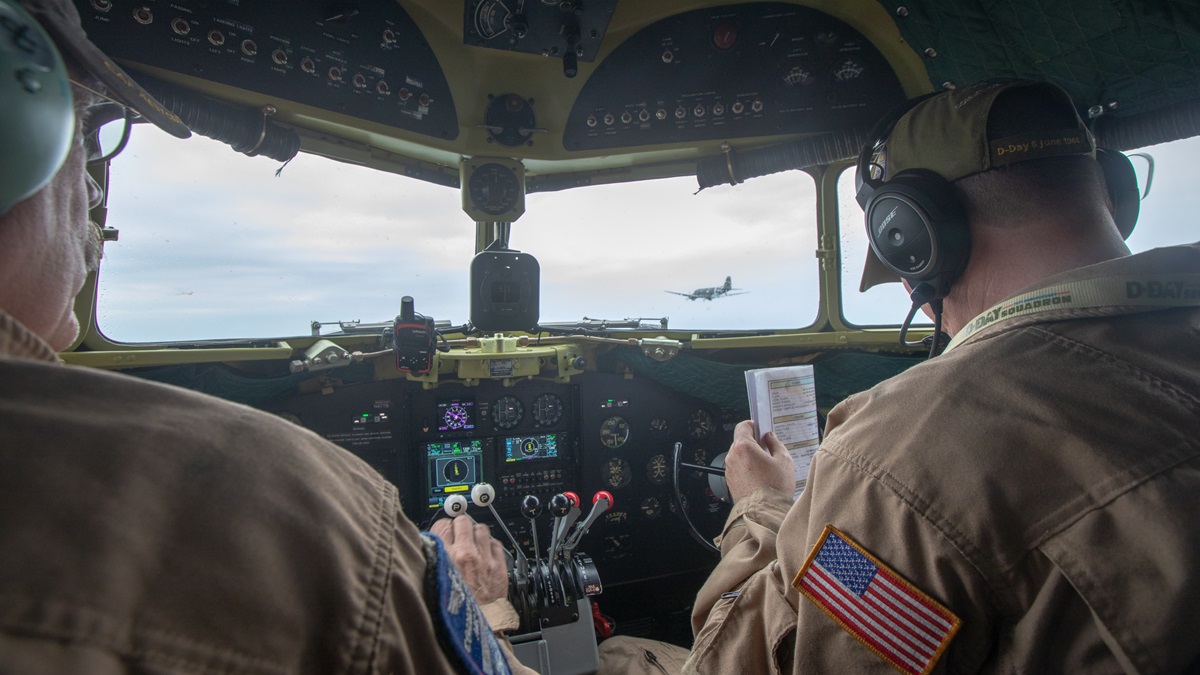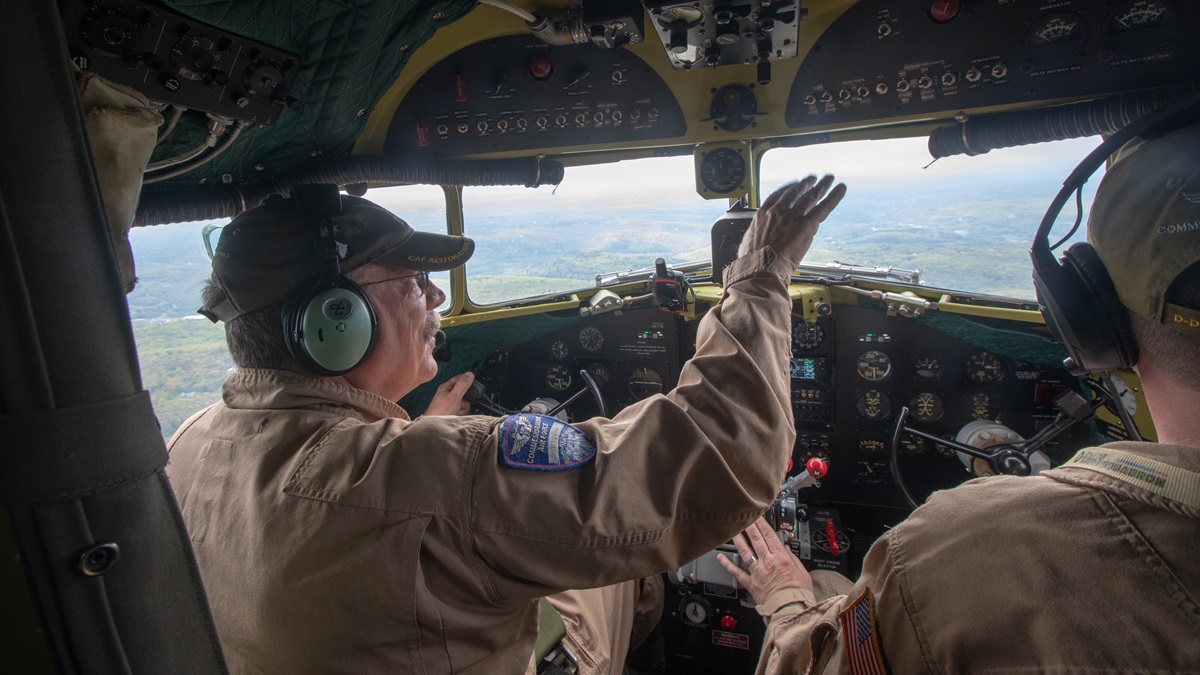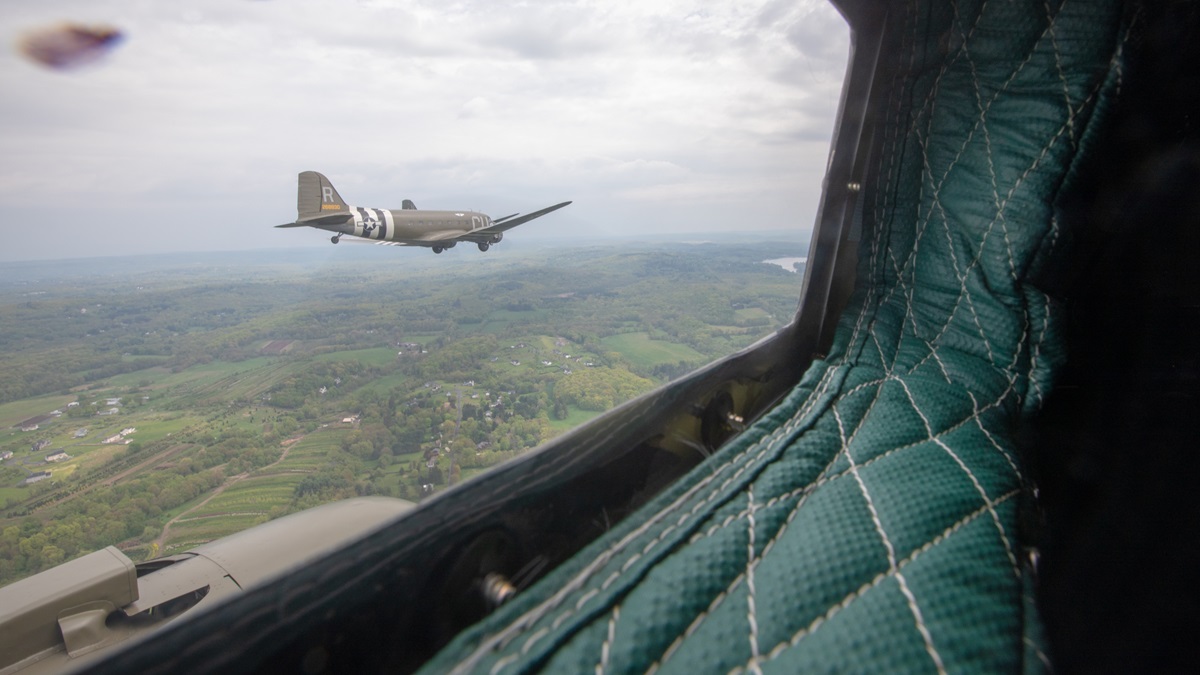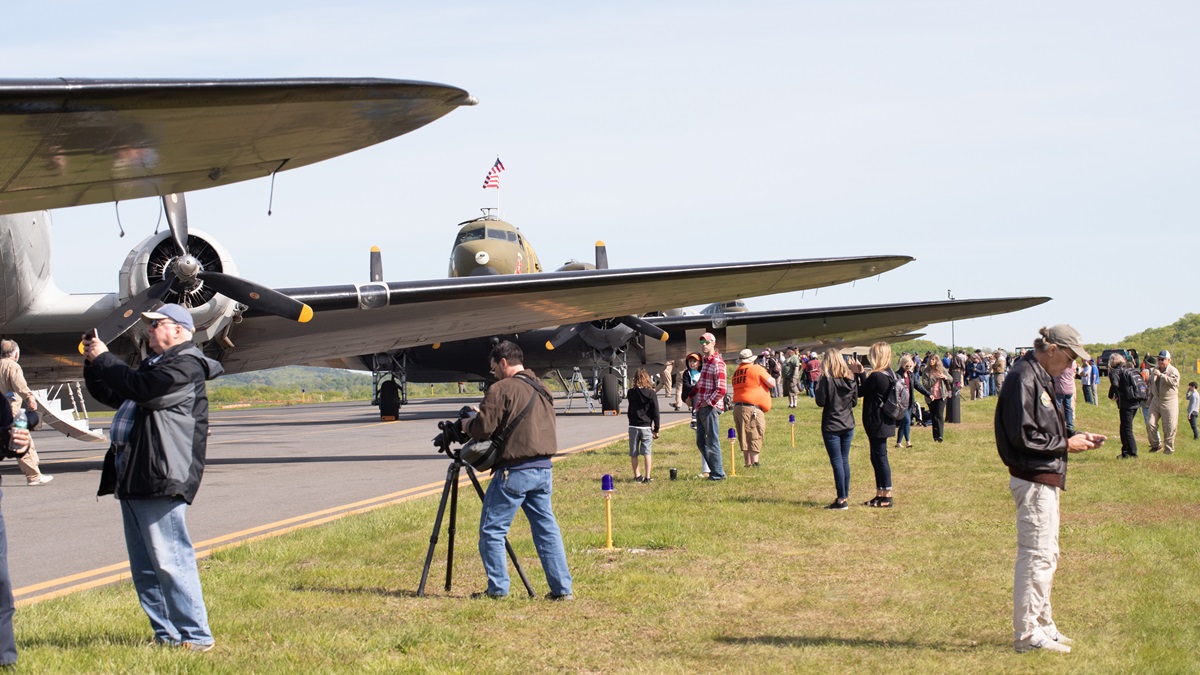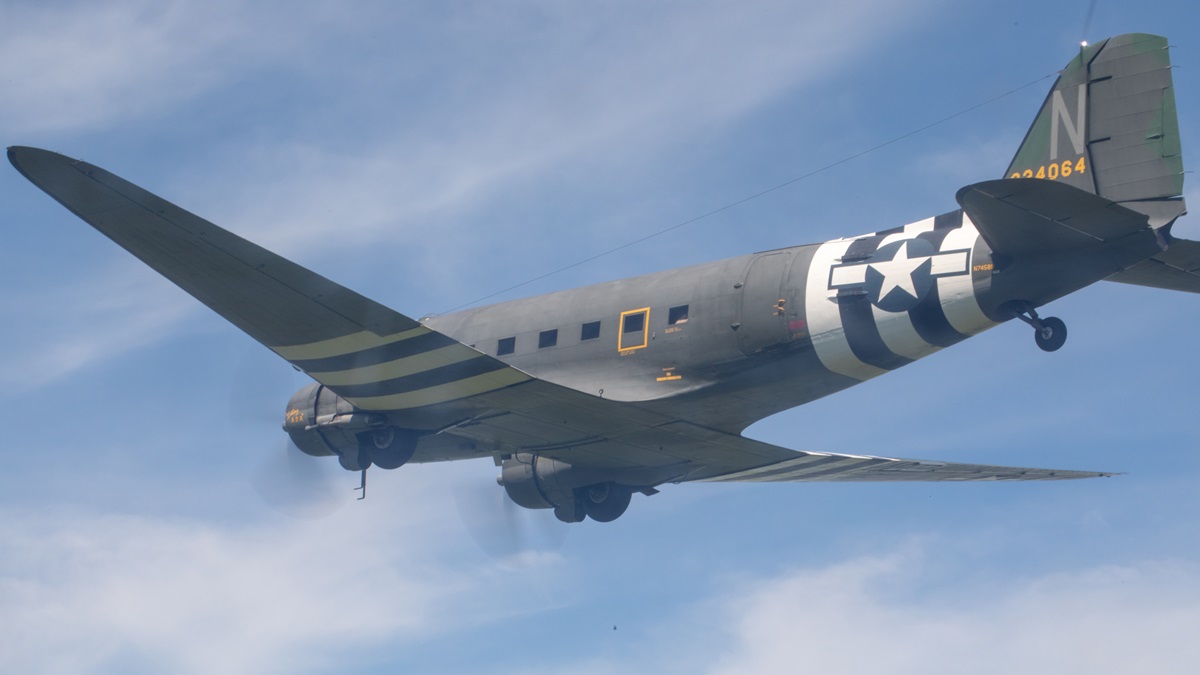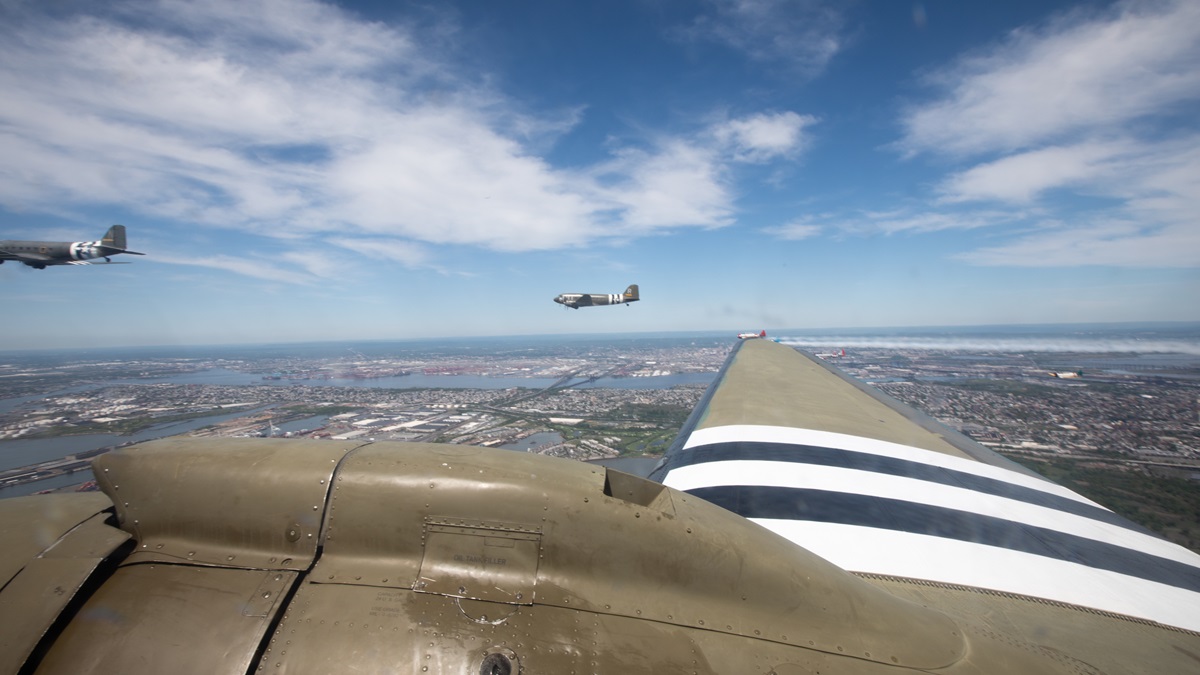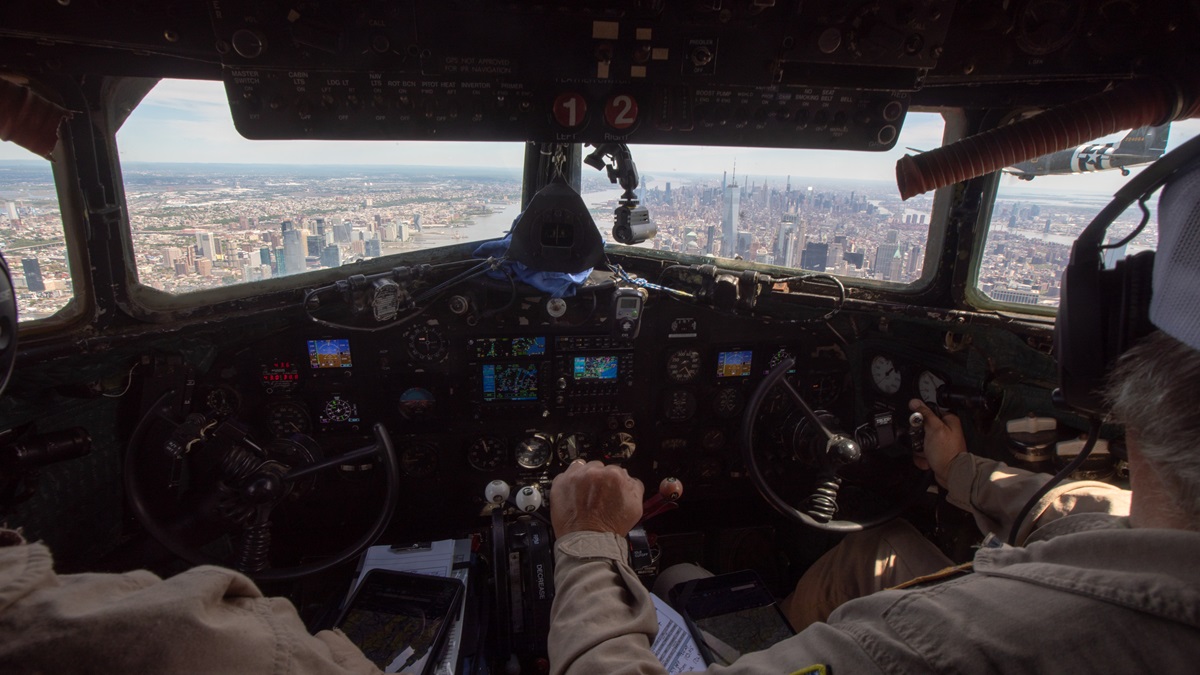Retracing the route to freedom
D-Day Squadron crosses Atlantic
Limber and well-oiled after a few days of local flights, the vintage airplanes of the D-Day Squadron lumbered down the runway with their massive radials roaring a basso profundo song of freedom, courses set for Presque Isle, Maine; Goose Bay, Labrador; and on to Greenland, Iceland, England, and France.
They aim to join up with others of their type from around the world, along with vintage fighter escorts, carrying among them an expected complement of 250 parachutists wearing period battle gear, and create the largest formation of C–47, DC–3, and C–53 troop transports seen since World War II. On June 5, if all goes according to plan, they will approach the coastline and the order will be given once more: “Stand up and hook up!”
They will fly and jump to remember the day Gen. Dwight D. Eisenhower issued his order of the day for June 6, 1944, addressing the soldiers, sailors, and airmen of the Allied Expeditionary Force:
“You are about to embark upon the Great Crusade, toward which we have striven these many months. They eyes of the world are upon you. The hopes and prayers of liberty-loving people everywhere march with you…”
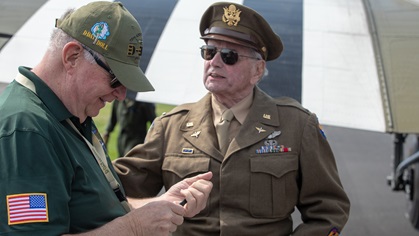
‘Like a prayer’
Retired Lt. Col. Dave Hamilton, 96, said he keeps a framed copy of that order on a wall in his Arizona home. Hamilton is the last surviving pathfinder, the pilot of one of 20 C–47s that flew under cover of night, 50 feet over the English Channel, carrying an elite group of paratroopers trained to be the first to touch down behind enemy lines and begin the brutal work of invading occupied France and beating the battle-hardened army of Nazi Germany back to Berlin.
“It was a like a prayer, really,” Hamilton recalled of the still-stirring message from the supreme commander as he sat aboard the Commemorative Air Force C–53 D-Day Doll, on May 17, at Waterbury-Oxford Airport in Connecticut. The D-Day Squadron was welcoming visitors and honored guests, and flying to practice and prepare to follow the same route across the North Atlantic that American aircraft had traveled 75 years before.
… Your task will not be an easy one. Your enemy is well trained, well equipped, and battle-hardened. He will fight savagely…
Hamilton said his navigator, assisted by radar installed in the pathfinder airplanes, deserves the credit for guiding them in predawn darkness through an inconvenient cloud bank and straight onto their target. Hamilton’s aircraft had no name. They were not allowed such niceties, not even allowed to stencil their own names under the windows. Their mission required utmost secrecy.
“We were the tip of the spear,” Hamilton recalled.
Just west of Sainte-Mère-Église, Hamilton emerged from that low cloud bank with two other aircraft that had separated from the main group, and his eyes strained to find and rejoin the formation in the darkness.
“We pulled up and I was just about to rejoin the group from the cloud bank and my navigator said, ‘don’t move, you’re perfect,’” Hamilton recalled. Drop Zone T (for Tear) was dead ahead, less than a minute away. “Stand up and hook up!” brought two dozen members of the 82nd Airborne Division, 507th Parachute Infantry Regiment, along with a military intelligence officer assigned to join them, to their feet.
“We found out later we were within 99 percent perfect, all three of us.”
Eisenhower had by then scribbled a handwritten note announcing the invasion had failed, that the men had fought bravely and the responsibility for their forced withdrawal from Normandy was his alone. That note would remain in Eisenhower’s pocket.
“They took quite a beating, the boys, once they got on the ground,” Hamilton recalled. “But they did their job.”
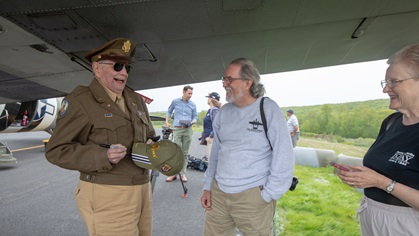
Hamilton and his crew did theirs, too.
While the U.S. Navy frogmen, forefathers of the SEALs, had come ashore and spiked the guns of one particularly dangerous nest of antiaircraft guns directly below their escape route, much to Hamilton’s relief, a 27mm round did find its way to his aircraft No. 14, tearing off part of a wingtip and smashing a cockpit window and the magneto controls mounted just above the windshield. Hamilton’s copilot was showered in metal and glass.
“He had his goggles and his helmet and everything off,” Hamilton recalled. “He just brushed himself off. We teased him about it.”
Back over the English Channel, still hours before That’s All, Brother would lead hundreds of C–47s into France carrying thousands more paratroopers to begin the main assault, Hamilton was called aft to look at the radar image showing hundreds and hundreds of warships steaming into battle.
“It looked like you could walk from England to the coast of France, all the dots on the radar from boats, unbelievable. And I said, ‘Wow.’ You started to get what the immensity of what we were involved in (was). That was our first realization of what an unbelievably large operation it was.”
Hamilton landed and “couldn’t turn the engines off the normal way, with no mags, so I had to starve the engines by cutting off the gas,” he recalled. There was a report to be filed, then a breakfast of steak and eggs, a debrief, and a glass of rye whiskey. “It happened to be very tasty.”
More flight assignments followed, dropping paratroopers in the south of France, then Belgium. More rewards were also in store for the pilot who celebrated his twenty-second birthday in July 1944.
“The French decorated me with the Legion of Honor,” Hamilton said, referring to France’s highest honor. “I’m going to wear that medal with pride over in France.”
Hamilton, who went on to serve in Korea, then fly Lockheed Constellations for an airline now relegated to history, will fly commercial this time. It is up to Eric Zipkin to get the D-Day Squadron safely across the Atlantic to take part in a series of events leading up to the seventy-fifth anniversary of D-Day.
‘Speak its language’
The D-Day Squadron is sharing its journey with the world on Facebook, posting live videos as they arrive at the stops along the route. They’ve broken formation, each aircraft making its own way, some opting for longer legs to take advantage of the C–47s' 1,800-mile range.
Zipkin, the founder and president of Tradewind Aviation in Oxford, Connecticut, is the D-Day Squadron director of air operations and the pilot of Placid Lassie, one of four participating aircraft that flew on D-Day. Hundreds of thousands of dollars have been raised from individuals and corporations, and the Douglas-built airplanes have been fitted with modern avionics to help them find their way.
“What goes through my mind is how good we have it now,” Zipkin said, noting that the navigation and communications tools available to Hamilton and his fellow airmen were nothing like the Garmin glass of today. Zipkin thinks of the men in their teens and early 20s who undertook a far riskier mission in 1944, and intends to honor their courage and sacrifice without risking losses as the vintage airplanes traverse the North Atlantic to England, then France.
“Not only an airplane like this, but actually these airplanes … these rivets around me, they actually flew across the Channel 75 years go. They were there,” Zipkin said. “It’s extraordinarily meaningful, and I count myself very lucky to be able to do that.”
Zipkin said the team allowed plenty of extra days to make the crossing to reduce the risk of pilots feeling extra pressure to fly in marginal weather, or if there were any other reason to delay in the interest of safety. He said “get-there-itis,” the bane of too many pilots, is indeed a concern.
“It is, and we built the project with at least 10 days of extra time” to complete the journey, Zipkin said. While that won’t entirely eliminate the pressure, “we would reduce it as much as possible.”
Another measure of risk mitigation was the pre-launch flight schedule in the days leading up to the May 19 departure. Zipkin said that vintage aircraft in particular need regular exercise to keep the moving parts lubricated and reduce the chance of a breakdown.
"These airplanes are made to fly, and that's what we do," Zipkin said.
Days before their May 19 departure, air crews practiced donning cold-water immersion suits and swimming in Lake Quassapaug in Middlebury, Connecticut, where Zipkin now lives. He called that particular exercise "eye-opening."

“No reason to think that’s gonna happen, but no reason not to be prepared,” said Doug Rozendaal, who flies That’s All, Brother for the Commemorative Air Force. “The emergencies you prepare for are not the ones that’ll get you.”
The airplanes were subjects of frequent attention on the ground as mechanics climbed ladders to service the engines, most of them Pratt and Whitney R-1830s made a few miles away in East Hartford, Connecticut. The squadron flew low over that factory in formation on May 15, lumbering up the Connecticut River to Bradley International Airport and the New England Air Museum. Each of these engines has 14 cylinders, 1,830 cubic inches of total displacement, and produces 1,200 horsepower.
“For an earlier radial, they’re a little bit fragile,” said Rozendaal, who has more experience flying the DC–3 than most—his first job as a commercial pilot was flying just such an aircraft. “They have very low tolerance for ham-fisted pilots. You never, ever close the throttles on a DC–3 abruptly.”
Some of the D-Day Squadron pilots compared the DC–3/C–47 to an overgrown and overpowered Piper Cub. They are known for being forgiving of mistakes, but Rozendaal said it is foolish to horse them around. Becoming proficient requires patience.
“If you think you’re going to take the bull by the horns and shove this airplane around and get it where you want it to be, it just won’t work very well,” Rozendaal said.
“Just on final today we got into some wake turbulence, and I pushed the rudder all the way to the stop and nothing happened,” Rozendaal said, describing a just-completed formation training flight with Placid Lassie and D-Day Doll. “But pretty soon, it started coming back, you know? Before it gets to where you want, you let off.”
The original DC–3 first flew in December 1935, and required just a few modifications to become the C–47, including installation of a hook to tow gliders, and replacement of the airline seats with metal benches lining each side of the cabin. Flying these aircraft in close formation requires some more anticipation, as the pilots demonstrated on May 18, running down the Hudson River Corridor past the Statue of Liberty, then back north past the Freedom Tower before turning east to Bridgeport, Connecticut, where the F4U Corsair fighter was made, for another overflight.
Rozendaal said the Douglas design has remarkably low drag for an aircraft large enough to haul 6,000 pounds of cargo on full tanks. Indeed, some were converted into gliders during World War II, and outperformed some purpose-built models.
“That represents a little bit of a challenge, you’ve got to be a long ways ahead of the airplane,” Rozendaal said. “When the lead airplane says he’s coming left to turn into you, before his airplane ever moves you have to start the turn. It’s an extremely clean airplane, very little drag, so when you bring the power off it doesn’t slow down quickly…. It’s just an airplane you have to come to terms with. You know, you have to learn to speak its language and be patient.”
Hamilton offered his own advice to pilots aspiring to fly the DC–3:
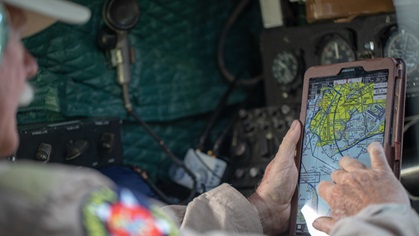
“I’d want you to basically know what your airplane's capabilities were. And then I’d want you to know never to exceed your own. ‘Cause those two things will keep you alive,” Hamilton said. “And then there is, whether you believe it or not, there is a modicum of luck involved.”
‘The ones that protected us’
Rozendaal said it is among his personal favorites to fly, and the significance of the Douglas Aircraft design’s place in history makes it that much more so. This was the first commercially successful airliner, a battle-hardened bird that served 72 years in military service from World War II through Vietnam, where its missions included dropping flares to light the night sky and expose enemy attackers.
“These are the ones that protected us,” said Jay Warden, 72, a Naugatuck, Connecticut, resident who served in 1968 and 1969 in Vietnam as an intelligence specialist. Warden followed the low rumble of those Pratt and Whitney radials to Waterbury-Oxford on May 17 to see the D-Day Squadron up close. One had flown straight over his home while he was mowing the lawn. He wore an AOPA hat, said he had learned to fly after leaving the military, inspired, in part, by the graceful lines and life-saving service of the C–47s that lit up the jungle night. “You didn’t really know the difference between day and night.”
The airplane's significance in history is hard to overstate. What other airplane can boast the same combination of longevity, utility, and impact on human lives? The D-Day Squadron’s mission also commemorates the Berlin Airlift, which is where Betsy’s Biscuit Bomber got her name, dropping food and medicine to the blockaded residents of West Berlin in 1948 and 1949.

In 1954, it was C–47s that supplied the French garrison at Dien Bien Phu, and flew the wounded safely out under enemy fire, when the soldiers were surrounded and utterly cut off. One could ponder an academic question, between that and D-Day, what was this airplane’s finest hour? How many such hours has it logged?
Rozendaal expects his fondest hour in this airplane is yet to come, likely when they approach the beaches of Normandy and salute men like Hamilton and the thousands upon thousands of others who risked everything to break the Nazi grip on Europe and the world beyond. It stands to become a career highlight, he said. This from a man who flew a B–25 at Gen. Jimmy Doolittle’s funeral, to name just one historically significant honor in a career with more than a few of them.
Hamilton was asked, if he had it to do over with his pick of any aircraft—the P–51 Mustang, the Spitfire, the B–25, or anything else in the Allied inventory of World War II, would he trade his seat in the C–47 for one of those?
“No,” Hamilton said, without hesitation. “Not with what I know. I still think I’d do it in this. Good old Gooney Bird. Saved my life too many times, yeah. And not necessarily because of my proficiency, either. A great-built and forgiving aircraft.”
